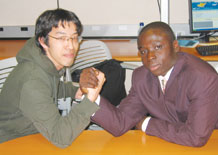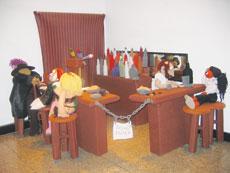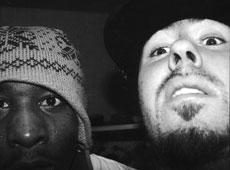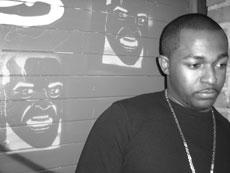Black/Asian Relations: Different Issues, Same Struggle

Brothers from another mother
April 5, 2006
Students of both Asian and African descent came together to share their experiences and views about the largely forgotten topic of African-American and Asian-American relations during a student-organized forum held on March 24.
John Tawa and Jesse Tauriac, graduate students in clinical psychology and the two coordinators of the meeting, said they wanted to provide a comfortable place for African-American and Asian-American students to express their opinions on the interracial relations which clinical psychology under-represents and instead focusing overwhelmingly on the white or white/black relations. After the meeting, Tawa and Tauriac said the turnout was more than they expected and appreciated the frank conversations between the participants.
Most all of the Asian-American participants had many positive memories with their black neighbors and the African-American participants expressed their admiration for Asian culture as well. But many from both racial groups agreed that it has been the white-centric media and racially segregated American society that have widened the psychological and geographical distances between the two groups and instead has encourage ignorance and hatred to dominate.
Tawa, who identifies himself as a Japanese American, said he hopes that he and the other students will be able to bring from the meeting a new perspective and that black/Asian relations can be more cooperative by recognizing their common goals, Their relationship is often associated with conflict or crisis, like the destruction of Korean stores by African-Americans during the Los Angeles Riot.
Tauriac, whose scholarly focus is academic resilience and its link with each person’s racial identity, said that being a dorm partner with Korean and Taiwanese students made him, an African American, more interested in the difficulties that Asian students face on campus in communicating with other racial groups.
The meeting consisted of two parts in which the participants were first separated into focus groups of their own race for 15 minutes so that they would feel more comfortable to express their opinions with each other, and then later both groups gathered back together for a 30-mnute collaborative session. Tawa and Tauriac asked the participants to keep each one’s identification and comments during the meeting confidential.
In the Asian focus groups, many of the participants, both American-born and foreign-born, said their first impressions of African-Americans were affected by negative stereotypes from the mainstream media.
One foreign-born student said his first encounters with black Americans came from toy figures such as Little Black Sambo, or from Michael Jordan and Carl Lewis, which fitted exactly with many of the racial stereotypes of black people as only being highly athletic or dangerous, immoral and stupid. This contradicted with the views of his activist parents who had admired people like Dr. Martin Luther King Jr. and Malcolm X, he explained.
Another student had many positive childhood memories with the black neighbors in his public housing project. Yet at the same time, he often found his parents being judgmental toward blacks without having much interaction with them.
In the collaborative session, many participants from both racial groups reached a consensus that the American racial and class structures divide them and make understanding each other difficult.
Participants said that the biggest obstacles are the mainstream textbooks, which teach American history mainly from a white perspective, underestimating the contributions that blacks and Asians have made. They said the biased views of history in their education play a crucial role since it is often the only way for people to learn about other non-white race groups.
One African-American student said that Boston, along with other major U.S. cities, is still segregated according to race and class such that people are confined to their own societies and people without interracial understanding. The black population predominately lives in Dorchester and Roxbury, Asians in Chinatown, and the white in the northern part of the city. “This country has improved [toward integrated society], but there still is a long way to go,” said the student.
Some participants said that they saw a common struggle in the many Asians living in the U.S., such as Cambodian and Vietnamese refuges, who have had similar experiences as those of the African descent who fled from the Caribbean or Africa. And once in this country, they are all the targets of racism by the U.S. government and society. They also said these difficulties they face would be common grounds to encourage the two groups to help each other’s racial uplift.
In American history, there actually have been many examples of interracial alliance between blacks and Asians. The Asian American political activists in the late 60’s were inspired by and learned community organizing and mass protests from the Black Power Movement and the Black Panther Party, to unite against racial oppression and to successfully demand ethnic studies programs. Dr. King and Malcolm X showed sympathy toward the Vietnamese and urged black Americans to support the Asians who struggled against the same U.S. government and its racism, militarism, and imperialism.
Tauriac said UMass Boston, which advertises its racial and ethnic diversity, is also a microcosm of the racially segregated American society, as most of its social events and class materials are still made up from the white perspective to limit opportunities for interracial understandings among students.
“The university has to make more effort to foster to represent a more diverse population,” said Tauriac. “There is much more to be done.”
Some black students said they liked Asian culture in general and respected the Asian communities’ sustainability, referring to Chinatowns and other Asian communities found around the globe.
Tawa and Tauriac are presenting a panel discussion on April 3 on the Black/Asian Relations inviting speakers from diverse ethnicity and genders as well as several participants from the meeting, in the Campus Center room 3540.

























































